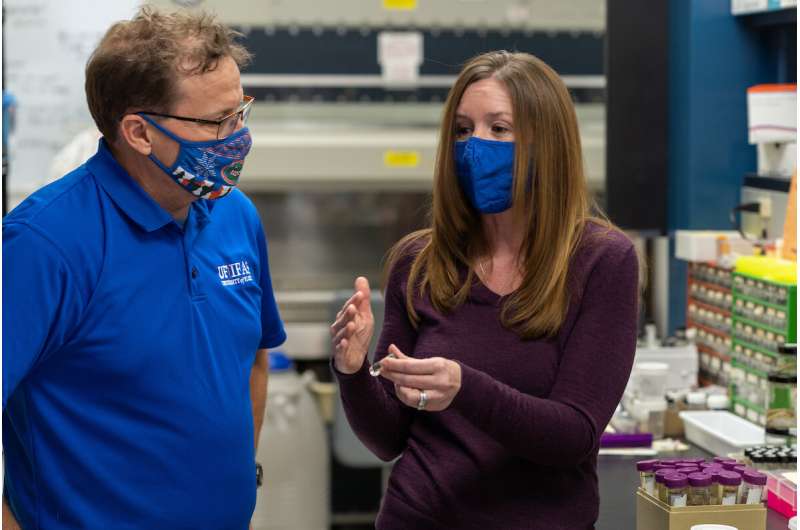Deadly rat lungworm parasite has spread to invasive Cuban treefrogs in Florida

University of Florida researchers report that the rat lungworm parasite, which can cause deadly disease in humans and in animals, has been found in a new host in Florida with its discovery in Cuban treefrogs, an invasive species.
The finding represents the first time an anuran—a frog or toad amphibian—has been identified as a host for the parasitic nematode in the state, although it has previously been identified in a variety of other hosts in Florida.
The frogs were found in Volusia County, where the rat lungworm had not previously been detected, the researchers said in a study published online Jan. 31 in the Journal of Wildlife Diseases.
“These frogs are going through the state, disrupting our native populations,” said Heather Walden, Ph.D., an assistant professor of parasitology at the University of Florida College of Veterinary Medicine and the study’s lead author. “They are eating native species, such as green treefrogs, and consuming not just the frogs and other food sources, but the parasites they carry with them.”
Walden’s laboratory examined 16 Cuban treefrogs from Volusia County for parasite species and confirmed the results by PCR. Her team recovered larvae from the rat lungworm, also known as Angiostrongylus cantonensis, from the frogs’ hind leg muscles.
Other studies Walden’s team has been involved in have documented the rat lungworm’s presence in Florida in gastropods—snails and slugs—as intermediate hosts and in rats as definitive hosts, as well as in non-human primates. The parasite has previously been found in Miami-Dade, Orange, Hillsborough, Alachua, St. Johns and Leon counties.
“The Cuban treefrog is extremely abundant in residential areas in peninsular Florida, often seeking shelter around homes that put them in close contact with humans,” Walden said. “If infected with parasites, this species’ association with humans indicates they have great potential to serve as agents of zoonotic transmission and may also threaten pets that consume them.”
Dogs, especially puppies, are by nature curious about their surroundings and explore the world through their mouths, Walden said.
https://youtube.com/watch?v=iIrkO_ZjKpM%3Fcolor%3Dwhite
“Although rare and not yet reported in Florida, dogs have become infected with rat lungworm by swallowing a snail or slug that carries infected larvae,” she said. “It’s very possible that a dog could eat a Cuban treefrog, or any other potential anuran host, and become infected as a result.”
In humans, infection with rat lungworm can cause meningitis, brain damage and blindness. In dogs, symptoms can include rear limb weakness and hind leg paralysis.
The Cuban treefrogs’ position in the food webs of Florida makes them well suited for the life cycle of a variety of parasites. They are known to eat a variety of snails, insects and even lizards and frogs. In addition, the close association of these anurans with humans can result in human-aided dispersal events capable of spreading their parasites to new geographic locations, the researchers said.
“The parasite itself is definitely a concern to humans and animals,” Walden said. “You have to ask: What would eat the Cuban treefrog, and how would the parasite affect that particular host? And if it does spread to other frogs, it’s the same question. What would eat those frogs?”
Native frogs might be more readily ingested, whether by humans or other animals, she added. The skin of the Cuban treefrog can be irritating to mucus membranes and not appetizing for many.
“Humans do eat frog legs,” Walden said. “While humans are not likely eating Cuban treefrogs, what other Florida frog species are infected with rat lungworm, and how are they affected? What we’ve found is just touching the surface.”
She added that while the Cuban treefrog’s role in the rat lungworm’s life cycle remains unknown, the findings are cause for concern, primarily due to its rapidly expanding geographical range.
Source: Read Full Article


